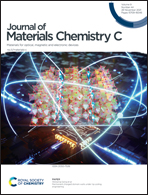A near infrared-II broad emission material with multi-spectral excitation and long persistent luminescence properties†
Abstract
Near-infrared (NIR) optical devices play an important role in non-destructive imaging and detection in vitro. In this work, Cr3+ single-doped and Cr3+,Er3+ codoped NaInGe2O6 (NIGO) luminescent materials with multi-excitation response (460, 660, and 808 nm) and long afterglow NIR-I and NIR-II emission properties were successfully synthesized by a high-temperature solid-state reaction method. The crystal structures, photoluminescence properties, long afterglow, and related mechanisms were studied in detail by multiple research and testing methods. In this system, most of the Cr3+ can occupy octahedral coordination in the [InO6] site, and a few ions will occupy the Ge4+ site to prevent crystal shrinkage. After Cr3+ is doped in NIGO, it can emit broadband NIR emission in the range of 700–1400 nm, attributed to the 4T2–2A2 transition. NIGO: Cr3+ has very weak crystal field intensity, which led to a relatively small Dq/B (1.72). The [InO6] octahedral coordination occupied by Cr is a distorted polyhedron that can reduce the orbital energy level to eliminate the degenerate state. These factors led to relatively long wavelength NIR emission that peaked at 935 nm as compared with other Cr3+-doped systems. The loose crystal structure and the method of copoint connection resulted in the easy deformation of the material at high temperatures, and this is the reason for the poor thermal quenching properties. NIR emission LEDs were fabricated by combining a blue 460 nm chip and a Cr3+-doped NIGO phosphor; they can effectively penetrate the palm, and blood vessels and bones emerge vividly. This means that NIGO: Cr3+ is a good NIR material for in vitro non-destructive imaging. Because NIGO: Cr3+ has a broadband NIR emission of 935 nm, its emission wavelength is closer to the absorption wavelength of Er3+, so the luminescent material NIGO: Cr3+ studied in this work has a better energy transfer match with Er3+ absorption. By codoping Cr3+,Er3+ into the NIGO system, the energy transfer from Cr3+ to Er3+ was realized by the effective overlap of the Cr3+ emission peak and Er3+ absorption peak. The spectrum of luminescent materials moved from the NIR-I to NIR-II region, and we obtained a multi-excitation response NIR-II emission luminescence material. NIGO: Cr3+ has long NIR emission afterglow properties of about 20 min because of the trap energy level coming from defects caused by changes in the valence state of Cr3+ to Cr4+. At the same time, we achieved a 1.54 μm emission NIR-II region with long afterglow by means of the afterglow energy transfer in Cr3+,Er3+ codoped NIGO. All the results indicate that NIGO: Cr3+ (Er3+) is a good NIR emission luminescent material with multi-functional application potential.



 Please wait while we load your content...
Please wait while we load your content...